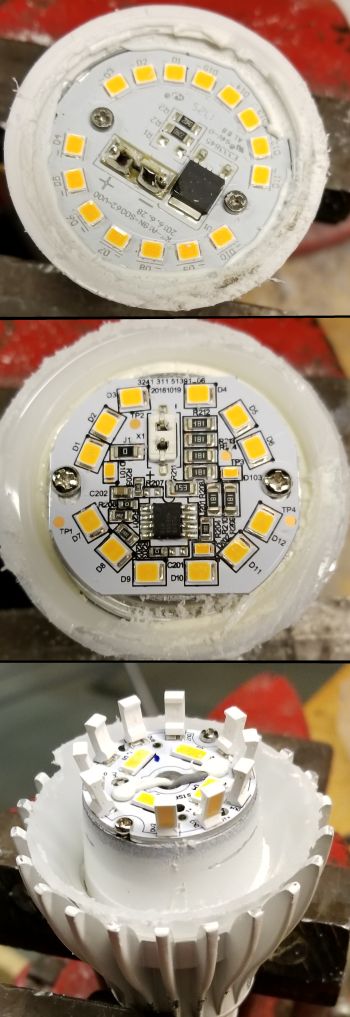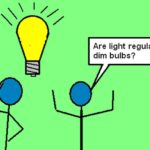A one-year burn-in test helps refute a small piece of fake news about LED bulbs.
We’ve torn down a number of LED bulbs over the years to analyze their content and design strategies. But when we published some of our findings a little over a year ago, we got this missive in the comment section:
In the end models after 1 year diodes produce 50% of initial light. If not dead.. Additional phosphor is transparent color is bluish. temperature is near of burn. Please make leds life easy they are good and for ever if work at 50% from beginning. I always open the lamps and correct power. If not possible -divide leds to two parallel branches. If not possible just connect lamps in pears serial and have 80% of each.
A couple of claims decipherable from this post is that LEDs lose half their light output after a year and their output shifts toward the blue part of the spectrum. Both these assertions are easy to disprove using published data from LED manufacturers. And when the Dept. of Energy tested LEDs, they found LED lights actually shifted in color over time less than other lighting technologies they tested (https://www.energy.gov/sites/prod/files/2017/04/f34/lsrc_colorshift_apr2017.pdf ).
Nevertheless, there is a segment of the population that doesn’t believe anything their government says and is suspicious of data generated by private companies trying to sell products. So in the interest of serving as an impartial source of LED data, we undertook a one-year burn-in test of three different LED bulbs. That one-year test recently wrapped up.
The bulbs we used came from EcoSmart, Sylvania, and FEIT. All were 60-W equivalent bulbs that were among the top ten highest rated LED bulbs by Consumer Reports. Beginning on Feb. 11, 2019 they sat undisturbed, lighting an unoccupied room 24/7. Our only interaction with them during that time was peeking in occasionally to make sure non of them had burned out. None did.
To do scientific measurements of light output requires a piece of test gear called an integrating sphere radiometer. This is basically a big spherical chamber whose internal surface is reflective white. The light from a bulb placed inside the sphere strikes the reflective walls, undergoes numerous diffuse reflections, then gets measured by a detector.

We don’t have an integrating sphere at our disposal. But we felt we could still get meaningful data because we were merely interested in before and after readings. All we had to do was measure the output of our bulbs in a test fixture, then perform the same measurement under exactly the same conditions one year later.
Our before-and-after measurements both took place on the same workbench. The environment around the bench was as close as we could muster to what it was one year earlier, but there could easily have been a few minor differences that contributed to some measurement error.
To gage light output, we employed a light meter called an LT45 made by Extech. It’s normally used for measuring and optimizing environmental light levels in places like office buildings, manufacturing plants and schools. Light meters like this one are used to verify regulatory compliance with local public safety codes and OSHA workplace lighting dictates.

To measure whether the LED bulb output had shifted to the blue part of the spectrum, we added an optical bandpass filter which only passes light in the blue-wavelength range, about 450 to 490 nm. Our blue bandpass filter (BP470-30.5) came from Midwest Optical Systems Inc. Its spectral range is 425 to 495 nm with a ±10-nm tolerance.
For testing, we put each bulb in a completely dark room and measured its illuminance using the light meter. The light meter sat one-foot away for measurements with and without the blue band-pass filter. These measurements let us read out how much light these bulbs put out after one year of burn-in. We could also calculate the percentage of blue light in the output from each of the bulbs.
Our results are rather anticlimactic. Two of the 60-W equivalent LED bulbs we measured showed no change in output after their one-year burn-in. The Sylvania bulb was down about 5.5%. That said, it is entirely possible that, given the less than 100% repeatability of our measurement environment, the difference measured in the Sylvania bulb output could easily be within our measurement error.

The results we saw for blue-light output were about the same as a year ago. In 2019, the average blue light output for the bulbs we tested was 1.4%. After the burn-in, the three bulbs measured slightly below that for an average of 1.03% of their output in the blue-light region.
Now for a few caveats. The bulbs in our burn-in test all sat at room temperature during the one-year test. Also, they remained powered up continuously for the 8,760 hours that comprised the test period. Some other studies have indicated that LED bulbs cycled on and off periodically may have shorter life spans, probably due more to problems in the power supply rather than to effects associated with the LEDs themselves.

Additionally, it should be noted that the DoE ran burn-in tests of sorts on LED bulbs back when it conducted the L Prize event for the first practical LED-equivalent to a 60-W incandescent bulb. The data from those tests, conducted around the 2009-2010 time frame, show a drop off in LED light output of only about 5% at worst after a three-year burn-in. The DoE used a test setup similar to ours in that the LED bulbs stayed on continuously over the burn-in period.

We doubt that LED bulb output qualities have worsened since the days of the L Prize. This leads us to believe most of the drop in the Sylvania LED bulb output we saw could be attributed to measurement error. Our teardown of these bulbs sheds some light, so to speak, on one possible source of error: The LED layout on the three brands of bulbs are all different. The bulb’s polycarbonate shell diffuses the light to make it less directional, but there is still a possibility that a measurement made off by a degree or two from vertical could yield a different light output reading.
The bigger point, of course, is that even if our measurements were off by a country mile, it’s clear that none of our LED bulbs lost anywhere near half their output. The results are yet another reason why you shouldn’t trust much of the claims you see online.






Lee, it is interesting to see the breakdown of failure modes. This matches my experience very closely. We have used EcoSmart from a big box building supply company and FEIT from one of the big Warehouse clubs. Both brands have had failures within the first 12 months usage. The failures have entirely consisted of electronic driver failures. Symptoms are all over the map, but eventually they just die because of no power to the LEDs.
The assertions of color change and light output seem contrary to long term LED experience when used as indicators. I have *never* seen an indicator LED replaced on a functioning piece of electronics due to loss of light output.
Perhaps what your example prose was trying to say about color was that the phosphor would “bleach” and become transparent which would shift the output towards the blue light exciter from a mix of blue and yellow. You have confirmed that such bleaching does not happen.
What most folks (and even many engineers) don’t realize is that these are “solid state florescent” bulbs. They work just like the old style gaseous tubes where a short wavelength light source excites a phosphor with the appropriate mix of elements to give the desired color temperature. As we all know, those gaseous tubes typically die from metal migration of the starting element rather than from phosphor degradation. In the solid state case, the phosphor is yellow and is excited by the blue LED underneath. The biggest difference from gaseous bulbs is that we also see the light from the blue LED exciter rather than having the UV exciter blocked from view.
In conclusion, the LEDs may very well last for the 50,000 hours, but you sure aren’t going to get that life out of the electrolytic capacitors in the drive circuit.
I’m not surprised that 3 bulbs from the top 10 highest rated lasted just fine, that’s what I’d expect, too.
Would love to see the experiment repeated with lowest-cost no-brand bulbs direct from China via eBay and see what happens.
My son purchased a few LED bulbs from Ikea a few years ago and one in the kitchen started pulsing on and off and finally quit. It should be noted that this bulb was enclosed in a glass covering attached to the ceiling so there was no ventilation at all. I took it home and took it apart and found one of the wires connecting to the mains was loose and not soldered very well. I tested the LEDs and they were all fine so there could be other issues besides the LEDs inside.
In our teardowns of LED bulbs done back in 2015, most of the bulbs we examined had hand-soldered connections from the PCB to the bulb plate and from the PCB to the ac socket. When we examined bulbs last year, most of the bulbs we looked at now had connectors on the LED plate and socket rather than hand-soldered wires.
I am guessing that the original post claiming such a power loss came from a third-world country where locally produced items were of very poor quality. My experience with poor quality third world products is that they do fail far sooner. the 48 inch florescent tube replacements at a friend’s restaurant had a 75% failure rate after about a year. One section of 24 LEDs would start to blink, then flash, and then go dark. These tubes were 96 LEDs in series strings of 24 each. An analysis showed that typically one or two LEDs in each string of 24 developed a much higher forward drop and went into some sort of thermal oscillation mode. These bright white LEDs ran with a forward voltage of around 3.3 volts at a current of around 60 mA.
I have first-hand experience with some white LED bulbs dimming, but they were not the high-power variety. A large “gumdrop” white LED declined in light output noticeably from week to week, until at 2 months, it was almost completely dim. This was driven by a CC power supply at slightly less than the device’s rated current (40 ma, if I remember correctly) To be fair, it came from one of the “hobbyist” outlets, rather than from a normal electronics distributor.
I have not seen dimming in commercial products intended for lighting, although I do see occasional electronic failures of the drivers.
Good design may also offer an explanation. Was consideration given to what percentage of maximum voltage the lamps were driven to, based on mfg design, versus the raw LED specs? Also, keep in mind ambient temperature and heat capture may have an effect (recessed insulated can versus up-lighting in a large open space).
I agree build quality, solid state supply issues (capacitors), and lumiere socket quality (ever notice center pole not quite making contact – years of plentiful solder on lamp tip versus the stingy amount today) play a larger factor.